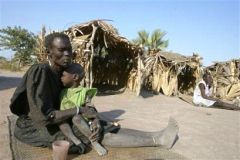Peacetime Sudan’s allure for returnees is deadly too
Oct 7, 2005 (RUMBEK) — Hundreds of thousands of people lured back to southern Sudan have high hopes of peace after a 21 year civil war, but warnings of chronic food shortage, poor infrastructure and desolate homelands peppered with landmines.
 The UN World Food Programme (WFP) estimates that nearly 645, 000 displaced people and 110, 000 refugees will return to their villages in October and November during the harvest season.
The UN World Food Programme (WFP) estimates that nearly 645, 000 displaced people and 110, 000 refugees will return to their villages in October and November during the harvest season.
“It is a big challenge for us and the government to welcome them. We have to settle them … take care of their security, education and health, ” said Jared Omyango, a local WFP official.
To date, at least 200, 000 people — of the estimated four million who were displaced — have returned to south Sudan in the wake of a peace accord signed between the government in Khartoum and the former rebel faction Sudan People’s Liberation Movement/Army (SPLM/A) in January, according to WFP.
But long-buried landmines, debris-strewn villages and rampant insecurity, coupled with underdevelopment, not only hinders a swift return, but lays bare the dangers such returnees face, aid workers and local SPLM officials.
“The biggest problems are economy and security, ” Father Andrea Haussman, a Catholic priest, told AFP in the provisional capital Rumbek. “People cannot settle well.”
In addition, officials fear that returning refugees could introduce crime and spread HIV/AIDS deeper into the region, where access to basic healthcare is already limited.
These challenges and a delay in the release of donor funds led the United Nations to caution in August that post-war reconstruction in southern Sudan is one of the most daunting challenges that humanitarian relief organizations have ever faced.
Since the peace accord, which ended a feud begun in 1983 when the Christian and animist south took up arms against the Islamic north, scores of southern Sudanese have been trekking back to their villages, only to find nothing remaining.
Abarku camp, some 12 kilometres (seven miles) north of Rumbek, is now home to about 450 returnees whose survival skills are stretched to the limits, despite recieving survival food rations from the WFP.
“We do not have enough food, no schools for our children, no medicines …, ” lamented Nora Sawa, a 46-year-old woman who fled the fighting in the south in 1985.
But Deng Wepi, 22, who escaped to the former government garrison town of Wau, northwest of Rumbek, prefers staying in the camps, where the WFP meets basic requirements like clean water, medicine and food.
With a steady influx of refugees in camps, the WFP is now focusing on expanding operations to serve an ever increasing population of repatriating refugees.
“We are gradually getting out of an emergency phase (and) focusing more on development projects, ” said the WFP’s Omyango.
In order to provide food supplies throughout the region, a team of UN deminers are currently clearing key roads to facilitate the flow of food supplies from Western Equatoria, the breadbasket of southern Sudan, to the barren lands in Sudan’s east.
The Catholic church has also joined in redevelopment efforts, racing to build schools to cater to newly returned children.
Despite their herculean efforts, aid groups have not yet been able to deliver sufficient supplies to tens of thousands of villagers living in the oil-rich, but militia-infested, areas of the Upper Nile region.
(AFP)
